The end of the school year means lots of close-out tasks for the teacher, including bulletin board removal, labeling and packing away items, and cleaning out the room to prepare for summer.
Problems with end-of-year close-out tasks arise when the teacher has things to do but the kids don’t. Students are perceptive—they know when we’ve given them busy work and are just trying to get them out of our hair, and we end up spending the whole day trying to keep them on-task.
I’m going to share a simple 4 step system I created for closing out and deconstructing your room in a single day.
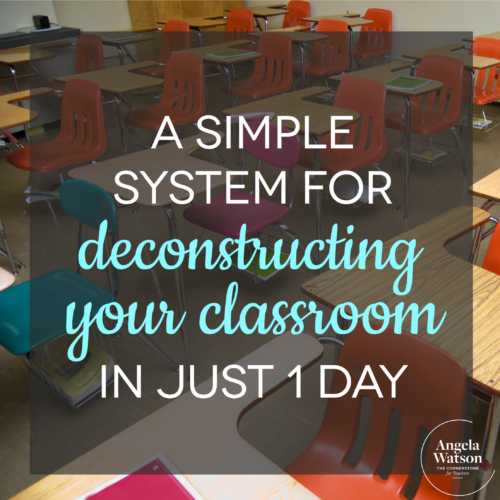
#1 Do everything BUT room deconstruction in advance.
Taking things off the walls will make it FEEL like you’ve made a lot of progress. But it’s really not accomplishing much, since it’s the fastest and easiest thing to do.
The actual deconstruction process can be so quick that I recommend you not even start it until the second to last day of school. Yes, really!
I’ve seen teachers close up their classroom libraries, centers, and so on a full month in advance so that they don’t feel overwhelmed with cleaning, organizing, and packing up the room during the last week. This throws off all their daily routines, and ramps up kids’ excitement levels and behavioral issues. I have experimented with many different approaches and can tell you without a doubt that it’s best not to have kids help deconstruct the classroom until the second-to-last day of school.
The final weeks of school are when you’ll complete your end of year paperwork, return materials, start organizing/decluttering, and all the other types of close-out tasks. Don’t confuse deconstructing the room with closing out your classroom. All the close-out tasks DO need to be done in advance.
Pace yourself during the last few weeks of school so you’re doing just a bit of close out paperwork and a few tasks at a time. (If you want help figuring out what that looks like, check out the resource linked above.)
However, you want to keep the classroom looking exactly the same for as long as possible so you can keep your regular routines in place, and on the second-to-last day of school, turn your full attention to overseeing classroom deconstruction.
If you do it any sooner or try to spread the tasks out over a week or two, it will be very difficult for the kids to concentrate on academic work because the room screams, “We’re done here!”
#2 List out all deconstructing jobs that students can help with
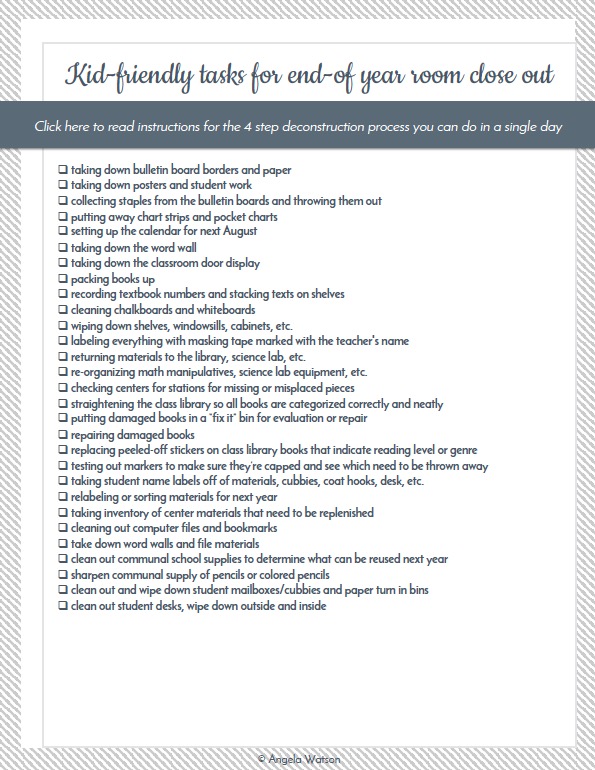
I usually had a list of about 30-40 jobs, and my third graders were able to complete every task on the list in less than two hours using the process I’m about to explain. We’d start around 10 a.m. and be done by noon, with a handful of miscellaneous tasks completed after lunch.
Once you know what needs to be done and have those tasks listed, you’re going to…
#3 Pair up students so you can assign tasks to them
You can either matching up names on a class list you keep privately, or display the list and and explain the pairs to your class. Give thoughtful consideration to students’ personalities when choosing the pairs: you want to match up kids who get along well so they can get the task done and won’t interrupt you to constantly settle arguments.
You also want to pair up kids who have similar strengths: for example, pair up your most organized students so they can do tasks like filing and library organization, and pair up students who are extremely active so they can move furniture and run errands around the school.
For secondary teachers (and others who see multiple classes each day), be sure to break down the jobs into tasks that can be completed within a single class period. You can also consider chunking the jobs so that each class participates to some degree, and the classes with your most responsible students are assigned the most important tasks.
Then, on the second-to-last day of school…
#4 Get the class engaged in a fun assignment while pairs of students take turns deconstructing
You’ll need meaningful, engaging independent work that the kids WANT to do so you don’t have to nag them to stay on task. Pick something fun!
While the rest of the class is working, call just a few pairs of students at a time to complete the deconstruction tasks.
Call one pair of students over to your desk and explain the task you’ve assigned to them. Once you’re confident they understand what to do and will be successful, call over another pair and assign the next task. I usually have about 2-5 pairs of students deconstructing the classroom at any given time. If things start to feel chaotic or difficult to manage, don’t call any more pairs until another pair has finished.
Whenever a pair of helpers finish their assigned tasks, they should automatically go back to completing the whole class assignment until you need them again. If they’re unable to do this quietly, don’t call them to help with anymore tasks.
Rotate through each pair of students as many times as needed until all the jobs are finished.
And that’s it–your entire room can be taken done in less than half a day! You can adapt this process in any way that makes sense for your teaching context, of course, but keep the 4 core elements in place, because that’s what makes it so effective.
Want editable checklists to show you what to do during each week?
Click to get my done-for-you system on sale now.
Here’s how this system worked for other teachers
The Stress-Free End of Year Close Out System is included in the 40 Hour Teacher Workweek Club materials. Hundreds of members tried this method last school year. Here are their results:
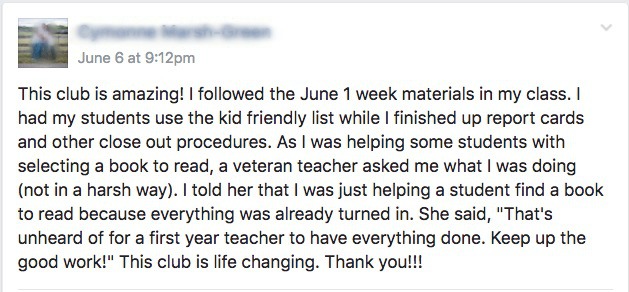
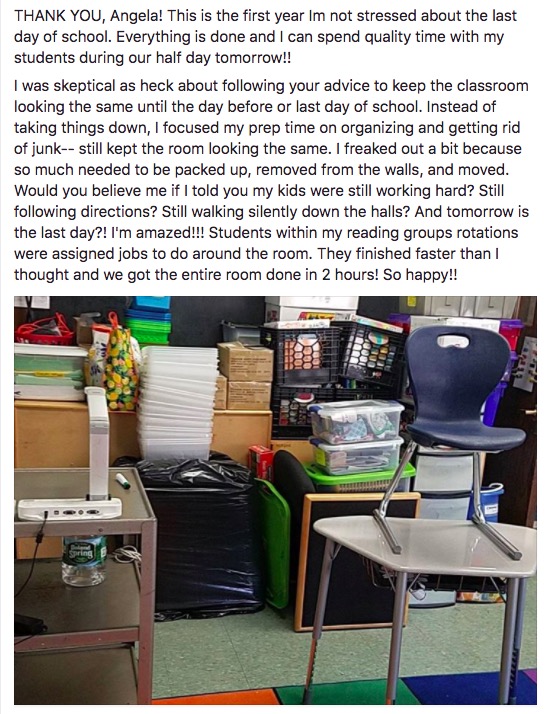
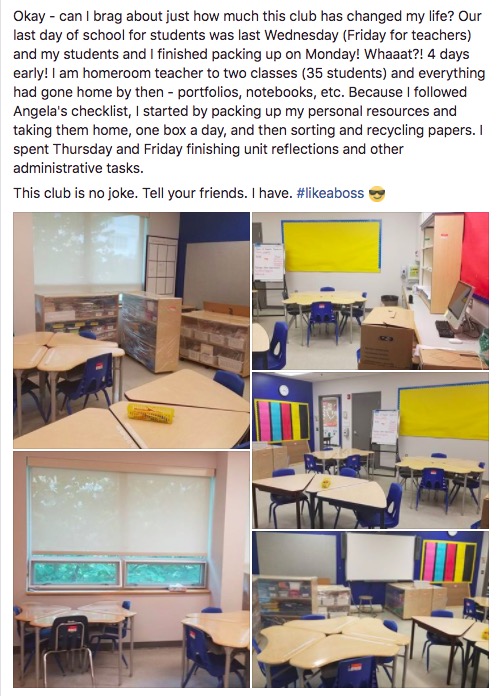
Here’s the secret to making the whole process come together …
Be 100% present with your kids — stay completely focused on them and classroom management during the room deconstruction process.
Make sure the majority of the class is engaged in worthwhile learning activities, and periodically circulate throughout the room to interact with kids and ensure they know what they’re doing. The rest of your time should be spent overseeing the students who are assisting with various end-of-the-year tasks.
That way, the kids know you aren’t distracted with your own end-of-year tasks, and they’ll take both the assignment and deconstruction tasks seriously.
Subscribe to the podcast and get new ideas weekly — it’s free!

Angela Watson
Founder and Writer
Sign up to get new Truth for Teachers articles in your inbox
Discussion
OR

Join our
community
of educators
If you are a teacher who is interested in contributing to the Truth for Teachers website, please click here for more information.

















I teach kindergarten, and we k teacher have so many manipulatives and hands on items used in teaching. I need ideas that are specific to to kindergarten for packing up at the end of the year.
These strategies also work for kindergarten. I used to teach PreK and my kids were a tremendous help with deconstructing. You may want to try putting away some of the manipulatives and centers early so kids have fewer choices during the last week of school, and then on the second to last day, pack away most of the remaining items.
hello Angela,you are very right.every child is capable of handling any task as long as its for their level.The only challenge is that often times ,teachers mostly under estimate their abilities.what I have observed is that these kids sure want to be part of deconstruction process.Just as Coach Angela has pointed,we really need to engage our pupils/students so we don’t overload our heads.I love you Angela for what you do.